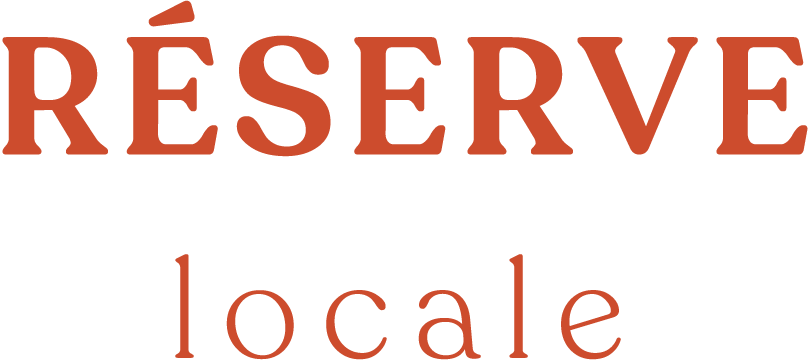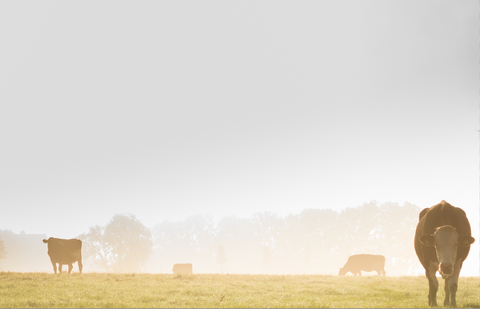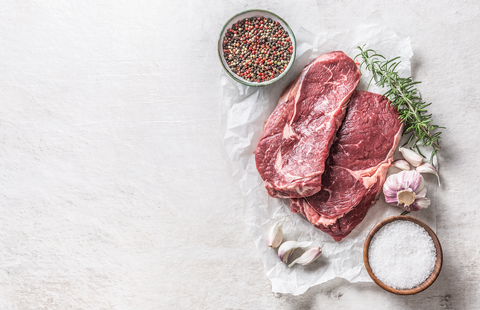As its name suggests, the ancestral diet is a nutritional plan based on the foods consumed by our ancestors. It is the act of returning to the sources, that is to say nourishing oneself mainly with healthy and natural foods which are little or not processed.
Ancestral food is LOCAL food.
It's about eating food from local farmers and markets. It's not only good for the environment, it's also a way to support the Quebec economy. Eating in an ancestral way means knowing where our food comes from. It’s knowing who grew them and how they were grown.
Ancestral food is SUSTAINABLE food.
The oxen are intended to be grass-fed. Chickens are meant to be raised on pasture. Vegetables are not supposed to be grown with chemicals. Our ancestors did not use antibiotics or growth hormones in their breeding technique. They didn't crowd animals into feedlots. They had animal welfare and respect for the environment at the heart of their priorities.
To learn more about the benefits of grass-fed beef, check out our article here !
The ancestral diet is SEASONAL.
Eating seasonal produce can be a difficult task. However, there are local markets that will make seasonal food much more accessible. This allows you to be in tune with the rhythm of nature. In addition, our food is healthier this way, because it has not traveled thousands of kilometers to get to us. Our ancestors had no other choice but to live according to the rhythm of the seasons. Although our resources are much more developed today, it is important to take this seasonal cycle into consideration for the sake of our environment.
Ancestral food means eating the best possible in a MODERN WORLD.
Today we are surrounded by fad diets, quick fixes and processed foods that are often very bad for our health and the environment. Without going hunting for food, it is possible to eat healthy and natural products. The main difference between an ancestral diet and a modern diet is the presence of modern, industrialized processes and ingredients in the creation of foods. An ancestral diet consists of whole foods free from industrialized methods and ingredients. In contrast, modern diets are characterized by foods that contain synthetic ingredients and are manufactured using industrial processes. We see this in most supermarkets, where the majority of foods offered are processed. The modern diet is characterized as products high in sugar, synthetic oils and empty carbohydrates, products that contain preservatives, artificial flavors and colors, products low in healthy proteins and nutrients.
The benefits of ancestral food on our health
The benefits of an ancestral diet lie in avoiding processed and unhealthy foods that are very present in modern diets. By following an ancestral diet, we avoid sugar, empty carbohydrates, synthetic oils and artificial ingredients responsible for much of the chronic illness we see in modern society.
IMPROVED GUT HEALTH
An ancestral diet favors foods that are better for digestion and microbiome diversity. Foods like sugars, refined flours and refined oils that are part of the modern diet are responsible for much of poor gut health. By following an ancestral diet, one can expect improved gut health.
A 2019 study published in PLoS One found highly diverse microbiomes in people who follow modern diets, and even compared them to traditional populations. Studies of ancestral populations who eat both animal and plant foods reveal greater microbial diversity than people who eat industrialized diets. It is possible to see that acellular carbohydrates, such as flours and refined sugars, wreak havoc on the intestinal microbiome.
MITIGATION OF METABOLIC SYNDROME
Metabolic syndrome is a group of conditions that coexist and increase the risk of heart disease, stroke and diabetes. These include high blood pressure, high blood sugar, and excess body fat. Metabolic syndrome is caused by mitochondrial dysfunction, which results from overconsumption of sugar. By following an ancestral diet, you reduce your sugar intake, which can help reverse metabolic syndrome.
In clinical trials, ancestral diets perform better than other diets recommended by national health organizations such as the American Heart Association . A number of studies lasting from a few weeks to two years show that a paleo diet improves blood pressure, body weight, waist circumference, triglycerides and cholesterol.
IMPROVEMENT IN BODY COMPOSITION
Ancient diets are free of processed foods high in sugars and carbohydrates, which are responsible for the obesity and poor body composition seen in modern society. Since ancestral diets are rich in nutrients, they are also more filling, which means consuming fewer calories. So, by following an ancestral diet, you can expect to lose fat, gain muscle, and improve your body composition.
A Stanford study showed that on average, people who cut back on added sugars, refined grains, and processed foods lost weight within 12 months, regardless of macronutrient ratios.
DECREASE IN INFLAMMATION
Chronic inflammation is a major catalyst for diseases such as diabetes, obesity, cancer, heart disease and arthritis. Sugar, refined carbohydrates and oils are all inflammatory and responsible for chronic inflammation. By following an ancestral diet, you avoid inflammatory foods and reduce inflammation.
Indeed, ancestral diets that eliminate these foods and focus on nutrient-dense whole foods, including both plant and animal products, have been shown to decrease markers of inflammation.
IMPROVEMENT IN QUALITY OF LIFE
Following an ancestral diet generally contributes to improved health and well-being, thereby improving quality of life.
It is commonly accepted that our Paleolithic ancestors lived on average to the age of 25 . The lower life expectancy observed in these studies was heavily skewed by higher infant mortality rates, lack of antibiotics, emergency medicine, etc. Without the development of chronic illnesses, these later years were probably of a much higher quality than those experienced by most older people today. An ancestral diet combined with the benefits of modern medicine will likely result in much longer than average health and lifespan.
The importance of proteins in ancestral diets
The human body assembles and uses approximately 50,000 different proteins to form organs, nerves, muscles and bones. All proteins are combinations of 22 amino acids, eight of which are so-called essential human nutrients, meaning the human body cannot make them. When essential amino acids are present in the diet, the body can usually make other non-essential amino acids. However, if a single essential amino acid is low or missing, the body is unable to synthesize the other proteins it needs, even if overall protein intake is high.
Proteins are essential for normal growth, hormone formation and many other functions of the human body. Animal protein is our only source of complete protein. All essential amino acids, as well as many amino acids considered non-essential, are present in animal products. The amount of animal protein we should include in our diet depends on our genetic makeup and hormonal factors. Some people need a lot of meat, while others don't produce enough hydrochloric acid in their stomachs to handle large amounts. Essential amino acid requirements vary greatly from person to person. However, what is certain is that the way we raise livestock will certainly change the benefits that animal proteins can provide to our bodies. The meat, milk and eggs found in our supermarkets are, for the most part, highly contaminated and their nutritional quality is much lower than that of the products available to our ancestors only a few decades ago. Modern breeding techniques include the use of growth hormones to make meat more tender and antibiotics that allow cattle to survive in crowded feedlots. Many cattle have never seen the outdoors, and calves are often confined to crates for their entire short lives. Sick animals routinely pass inspections and end up in the food supply. Chickens are raised in overcrowded enclosures, often under artificial light day and night, and are fed substandard feed. They too must be protected from infections with antibiotics. Their eggs have lower nutritional qualities than eggs from free-range and properly fed hens. According to renowned cancer scientist Virginia Livingston-Wheeler, most chicken and nearly half of the beef consumed in America today is cancerous and disease-causing.
The educated consumer and the enlightened farmer can, together, promote the return of mixed farming, where fruit and vegetable growing is combined with livestock and poultry raising in an efficient, economical and environmentally friendly manner. environment and animals. Livestock, which provides rich manure, is the absolute basis of healthy and sustainable agriculture. Additionally, chickens that have access to pasture eat ingredients natural to them and therefore end up with high quality eggs. Beef that are grass-fed and pastured allow the land to regenerate and keep them healthy without the need for antibiotics to treat illnesses. It is not livestock that is causing environmental destruction, but rather misguided agricultural practices and monopolistic distribution systems. Without stopping eating meat, it is important to stock up on meat, fish and seafood that has been raised responsibly, sustainably and whose provenance is known.
Creating change one plate at a time
Réserve Locale encourages local producers who respect the environment and animals, producers who wish to return to their roots. Our partners and our products have been carefully chosen to allow Quebecers to eat differently and offer them ancestral food.
BEEF
Our beef is grass-fed, meaning it has spent its life grazing on grass in a pasture. Being a ruminant, beef does not have the capacity to properly digest the different grains that conventional breeding offers it. A natural grass-fed diet produces leaner meat, richer in antioxidants and vitamins, and contains twice the omega-3 fatty acids than conventionally raised beef. Our partners raise high quality beef, without using antibiotics or hormones. From an environmental point of view, grass feeding on pasture is incomparable . By grazing on grass, cattle allow the soil to absorb and store carbon. On the contrary, in conventional livestock farming, the heavy machinery used on the many fields dedicated to feeding beef exposes the carbon buried in the soil to the air and converts it into CO2.
CHICKEN
In conventional farming, chickens are fed grains, but also flour made from animal by-products. Having very little space to move around, chickens are fatter. To cool the chicken, its flesh is immersed in water, which means that it will lose volume when cooked. At the Ferme des Voltigeurs , as well as at Les Viandes Bio de Charlevoix, the chickens feed on 100% vegetable grains, benefit from a larger space to move, do not receive any preventive antibiotics and are cooled in the air and not in the air. the water. Organically raised chickens benefit from grains grown without the use of pesticides, insecticides, chemical fertilizers or GMOs. The chickens also have access to the outdoors and can therefore eat all-natural ingredients while taking advantage of daylight.
PORK
Living without a cage in a stimulating environment three times larger than normal, the Rank 4, DuBreton Rustique and Viandes Bio de Charlevoix pigs do not experience any physical alteration, such as teeth and tail trimming, which is unfortunately systematic in breeding. conventional. The pigs are fed unmodified plant grains, in addition to being raised without hormones or antibiotics.
TURKEY
The Avibross farm, located in the Victoriaville region and belonging to the Brosseau family, offers natural turkey, without antibiotics and without animal substitutes. Fed with vegetable grains, the turkey has lean, protein-rich flesh.
LAMB
More than 60% of the lamb you find in supermarkets comes from New Zealand, Australia or Alberta. Quebec Lamb deserves to be known and that is why we promote Agneau de Chez-Nous products, which are recognized for their responsible breeding practices.
CALF
Montpak raises its calves with a formula of grains fortified with vitamins and minerals which ensures the proper development of the animal, promotes a better nutrient content and offers a delicate taste. Such tasty and versatile meat is the result of this diet maintenance which produces lean meat, low in fat and cholesterol and rich in iron and protein.
GAME
Nutritionally and environmentally, game meat is probably one of the best choices. The Northfork Ranch raises deer and bison on pasture, which allows the animal to graze on the grass (without pesticides) of the fields and, therefore, to conserve the biodiversity of the soil and the surrounding nature. In other words, this type of breeding could not be more natural and more respectful of the environment, since we truly offer a wild life to the animals.
FISH & SEAFOOD
Our fish comes from accredited sustainable fisheries, as well as controlled aquaculture. Our suppliers' partner fisheries have accreditations from the MSC, ASC and Ocean Wise. We prioritize fishing that takes place in Quebec, but to offer interesting diversity to our customers, certain products that are indicated could be fished on the coasts of British Columbia, in Iceland or in Argentina (shrimp).
To view our products, click here !
Sources used for writing this article:
Boers, I. (2014). Favorable effects of consuming a Palaeolithic-type diet on characteristics of the metabolic syndrome: a randomized controlled pilot-study. National Library of Medicine. https://pubmed.ncbi.nlm.nih.gov/25304296/ .
FALLON, Sally. (2001). “Proteins” in Nourishing Traditions: The Cookbook that Challenges Politically Correct Nutrition and Diet Dictocrats. Washington. NewTrends Publishing, Inc. p. 26-31.
Gardner, C et al. (2018). Effect of Low-Fat vs Low-Carbohydrate Diet on 12-Month Weight Loss in Overweight Adults and the Association With Genotype Pattern or Insulin Secretion. Stanford Prevention Research Center. https://jamanetwork.com/journals/jama/fullarticle/2673150 .
Gurven, M & Kaplan, H. (2007). Longevity Among Hunter-Gatherers: A Cross-Cultural Examination. Wiley Online Library. https://onlinelibrary.wiley.com/doi/abs/10.1111/j.1728-4457.2007.00171.x .
Masharani, U. (2015). Metabolic and physiologic effects from consuming a hunter-gatherer (Paleolithic)-type diet in type 2 diabetes. National Library of Medicine. https://pubmed.ncbi.nlm.nih.gov/25828624/ .
Pastore, R et al. (2015). Paleolithic nutrition improves plasma lipid concentrations of hypercholesterolemic adults to a greater extent than traditional heart-healthy dietary recommendations. National Library of Medicine . https://pubmed.ncbi.nlm.nih.gov/26003334/ .
Pickworth, C et al. (2019). Randomized controlled trials investigating the relationship between dietary pattern and high-sensitivity C-reactive protein: a systematic review. National Library of Medicine. https://pubmed.ncbi.nlm.nih.gov/31222367/ .
PLoS One. (2019). Gut microbiome response to a modern Paleolithic diet in a Western lifestyle context. PLoS One. https://www.ncbi.nlm.nih.gov/pmc/articles/PMC6687155/ .






Comments (0)
There are no comments for this article. Be the first to leave a message !